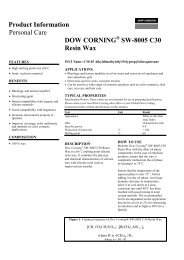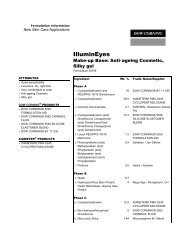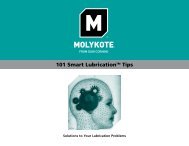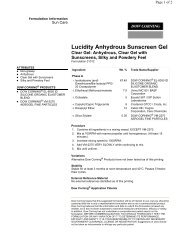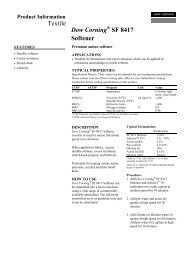Silicone Rubber Coating Process
Silicone Rubber Coating Process
Silicone Rubber Coating Process
You also want an ePaper? Increase the reach of your titles
YUMPU automatically turns print PDFs into web optimized ePapers that Google loves.
DISPERSION COATING WITH SILASTIC SILICONE RUBBER<br />
The <strong>Coating</strong><br />
<strong>Process</strong><br />
Selecting the Fabric<br />
Silastic silicone rubber coatings are often used where heat<br />
stability and good electrical properties are required. Since<br />
glass cloth is also excellent in these respects, it is the fabric<br />
most often dispersion-coated for such application. Usually<br />
heat-treated glass fabric with a surface treatment is used.<br />
Nylon, Dacron, Orlon and other fabrics can be used where<br />
resistance to high temperatures is not required.<br />
Priming<br />
To obtain maximum adhesion of the dispersion, treat the<br />
fabric with a primer before coating. Several suitable primers<br />
are available from Dow Corning. In some cases, a 5 to 15<br />
percent dispersion of the Silastic silicone rubber can be used<br />
in place of a primer. The proper concentration of primer<br />
depends on the fabric. Hard-finished fabrics require a higher<br />
concentration than soft, porous fabrics, since they pick up<br />
less of the solution. Primer is conveniently applied by<br />
unrolling the fabric and running it through a dip tank.<br />
As the solvent evaporates from the fabric, the primer<br />
hydrolyzes by exposure to moisture in the air, forming a film<br />
that bonds securely and uniformly to silicone rubber in<br />
dispersion. At normal room temperature and humidity,<br />
solvent evaporation and primer hydrolysis are completed<br />
within half an hour after dipping. If the fabric cannot be<br />
draped and exposed to air for half an hour, warm it while the<br />
solvent evaporates, then dry it for 5 minutes at 150°C to<br />
complete the hydrolysis. A coating tower can be used for this.<br />
In dry areas it may be necessary to introduce moisture so<br />
hydrolysis will occur.<br />
CAUTION: Most solvents used in dispersions and primers<br />
are flammable or combustible; and chlorinated solvents,<br />
though not flammable or combustible, may produce toxic<br />
vapours. Accordingly, an exhaust system of ample capacity<br />
must be provided for the dip tank and for the heated zones -<br />
particularly, the solvent-removal zone -to make sure that the<br />
vapour concentration is kept below the maximum allowable<br />
for the solvent used.<br />
3
Reverse-Roll <strong>Coating</strong><br />
<strong>Coating</strong> Procedure<br />
Production coating of fabric with Silastic silicone rubber<br />
dispersions is usually carried out in a coating tower. The<br />
fabric is unrolled and fed continuously through the dispersion<br />
in a dip tank, then through a heated vertical tower for<br />
vulcanization and onto a takeup roll.<br />
The fabric is wetted best when it enters the dispersion at an<br />
angle of about 45 degrees; at this angle, it is not so likely to<br />
trap air in its interstices.<br />
In most cases, dispersions containing 15 percent to 25 percent<br />
solids are used. The exact solids content will vary with the<br />
specific gravity of the rubber, the viscosity of the dispersion,<br />
and the coating method.<br />
The following methods are used:<br />
Dip-and-Flow <strong>Coating</strong><br />
This method is used where relatively thin coatings such as<br />
size coatings are desired. A low concentration of dispersion is<br />
used to provide free flow. The cloth is passed through the dip<br />
tank, and the excess dispersion flows off the cloth as it leaves<br />
the tank. The thickness of coating is controlled by varying the<br />
concentration of the dispersion, the speed of the cloth through<br />
the dip tank, or both.<br />
4
Knife or Rod <strong>Coating</strong><br />
This method is the same as the dip-and-flow method except<br />
that after dipping the fabric is drawn past a knife or rod on<br />
one or both sides to strike off the excess dispersion.<br />
Ordinarily, higher solids content dispersions are used than in<br />
dip-and-flow coating, and heavier coatings can be obtained.<br />
Thickness of coating is controlled by the concentration of the<br />
dispersion, the distance between the knife or rod and the<br />
cloth, and coating speed.<br />
A grooved or threaded rod helps control the uniformity of<br />
coating, as well as the thickness (the coarser the thread, the<br />
thicker the coating). If the thread tends to leave ridges, this<br />
can be remedied by allowing the rod to rotate freely. With a<br />
threaded rod, the viscosity of the dispersion is less critical<br />
than with a knife or unthreaded rod.<br />
With this coating method, a roll rotating opposite to the<br />
movement of the cloth is used in place of rod or knife. Some<br />
manufacturers find that more complete penetration is<br />
obtained with this method.<br />
Drying and Vulcanization<br />
Usually, the coating tower has three zones or sections:<br />
• a solvent-removal zone,<br />
• an intermediate vulcanizing zone, and<br />
• a final vulcanizing zone.<br />
The temperature of the solvent-removal zone should be held<br />
below 80°C, to avoid degrading the vulcanizing agent and to<br />
minimize the danger of fire. Note that the temperature and<br />
length of this zone must be great enough that the fabric is<br />
solvent-free before it enters the hotter zones above.<br />
For glass fabrics, the intermediate vulcanizing zone is<br />
generally held at about 200°C, and the final vulcanizing zone<br />
is often operated at temperatures as high as 316°C. In<br />
general, the temperatures in these two zones should be as<br />
high as practicable without producing blisters on the fabric.<br />
This is especially true for very thin coatings, to avoid loss of<br />
vulcanizing agent before the rubber vulcanizes.<br />
For a typical operation-coating .1mm glass cloth to an overall<br />
thickness of .25mm -the time in the solvent-removal zone is<br />
about 4 minutes; in the intermediate vulcanizing zone, 2<br />
minutes; and in the final vulcanizing zone, 3 minutes. For<br />
very thin coatings, these times can be shortened. For heavy<br />
coatings, longer times are required.<br />
In dispersion-coating organic fabrics, make sure that the<br />
temperatures do not exceed the decomposition temperature of<br />
the fabric.<br />
The rubber should be completely vulcanized before it goes<br />
over the top roll, to prevent the coating from picking-off on<br />
5
the roll. If complete vulcanization cannot be obtained, the top<br />
roll may be heated to vulcanize the rubber more completely<br />
and prevent pick-off.<br />
Where unvulcanized coated fabric is produced, a liner of<br />
polyethylene or other suitable material must be inserted<br />
before the fabric goes over the top roll -to prevent picking-off<br />
of rubber on the top roll and idler roll, and to prevent<br />
adhesion between layers on the takeup roll Silastic silicone<br />
rubber can be bonded to many materials, including metals,<br />
glass, ceramics, most plastics, silicone-glass laminates,<br />
fabrics, and silicone rubber itself. There are two ways of<br />
doing this:<br />
• Using unvulcanized rubber, and obtaining adhesion as the<br />
rubber vulcanizes.<br />
• Using vulcanized rubber, with an adhesive to provide the<br />
bond.<br />
In most cases, a primer is also needed to assure the best bond<br />
between the surface and the adhesive.<br />
6


